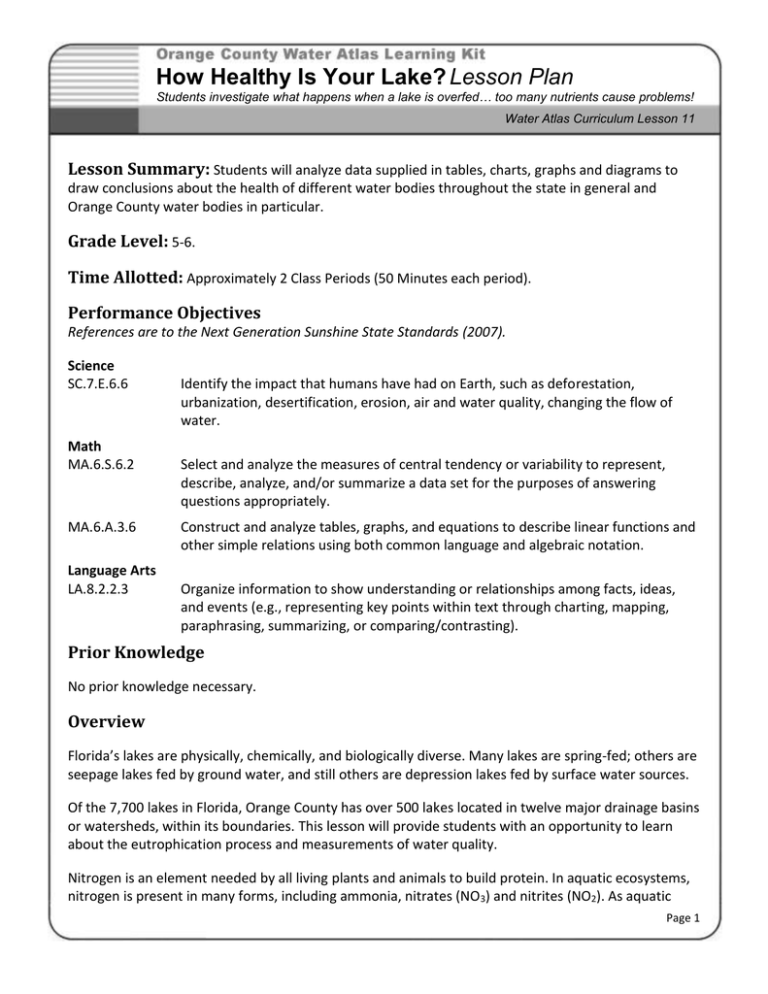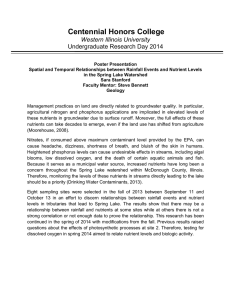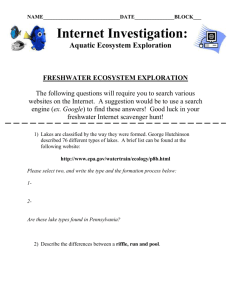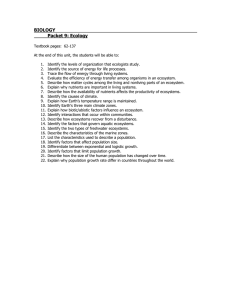How Healthy Is Your Lake? Lesson Plan
advertisement

How Healthy Is Your Lake? Lesson Plan Students investigate what happens when a lake is overfed… too many nutrients cause problems! Water Atlas Curriculum Lesson 11 Lesson Summary: Students will analyze data supplied in tables, charts, graphs and diagrams to draw conclusions about the health of different water bodies throughout the state in general and Orange County water bodies in particular. Grade Level: 5-6. Time Allotted: Approximately 2 Class Periods (50 Minutes each period). Performance Objectives References are to the Next Generation Sunshine State Standards (2007). Science SC.7.E.6.6 Math MA.6.S.6.2 MA.6.A.3.6 Language Arts LA.8.2.2.3 Identify the impact that humans have had on Earth, such as deforestation, urbanization, desertification, erosion, air and water quality, changing the flow of water. Select and analyze the measures of central tendency or variability to represent, describe, analyze, and/or summarize a data set for the purposes of answering questions appropriately. Construct and analyze tables, graphs, and equations to describe linear functions and other simple relations using both common language and algebraic notation. Organize information to show understanding or relationships among facts, ideas, and events (e.g., representing key points within text through charting, mapping, paraphrasing, summarizing, or comparing/contrasting). Prior Knowledge No prior knowledge necessary. Overview Florida’s lakes are physically, chemically, and biologically diverse. Many lakes are spring-fed; others are seepage lakes fed by ground water, and still others are depression lakes fed by surface water sources. Of the 7,700 lakes in Florida, Orange County has over 500 lakes located in twelve major drainage basins or watersheds, within its boundaries. This lesson will provide students with an opportunity to learn about the eutrophication process and measurements of water quality. Nitrogen is an element needed by all living plants and animals to build protein. In aquatic ecosystems, nitrogen is present in many forms, including ammonia, nitrates (NO3) and nitrites (NO2). As aquatic Page 1 How Healthy Is Your Lake? Lesson Plan Students investigate what happens when a lake is overfed… too many nutrients cause problems! Water Atlas Curriculum Lesson 11 plants and animals die, bacteria break down large protein molecules into ammonia. Ammonia is then combined with oxygen (oxidized) by bacteria to form nitrites and nitrates. Excretions of aquatic organisms are very rich in ammonia, although the amount of nitrogen they add to the water is usually small. Ducks and geese, however, contribute a heavy load of nitrogen from excrement in areas where they are numerous. Decomposition of dead plants and animals also releases nitrogen into water sources. Excess nitrogen, in the form of ammonia and nitrates, can cause overgrowth of aquatic plants and algae. As more plants and algae grow and die, the amount of dissolved oxygen in the water is decreased. This may compromise the well-being of other aquatic organisms that rely on a high level of dissolved oxygen. Eutrophication is a process whereby water bodies, such as lakes, estuaries, or slow-moving streams receive excess nutrients that stimulate excessive plant growth. The plants can be algae and/or nuisance plants and weeds. This enhanced plant growth, often called an algal bloom, reduces dissolved oxygen in the water when the dead plant material decomposes and can cause other organisms to die. Nutrients can come from many sources, such as fertilizers applied to agricultural fields, golf courses, and suburban lawns; deposition of nitrogen from the atmosphere; erosion of soil containing nutrients; and sewage treatment plant discharges. Water with a low concentration of dissolved oxygen is called hypoxic. In summary, eutrophication occurs when a water-based ecosystem has too many nutrients. This phenomenon is also called nutrient loading. Unlike on land where excess nutrients can leave the soil an don’t cause too much damage, excess nutrients in bodies of water have nowhere to go and the result can be disastrous. Key Vocabulary Chlorophyll a A specific form of a green pigment used by plants to carry out photosynthesis. Dissolved oxygen (DO) Oxygen that is freely available in water to be used by fish, macro invertebrates, and other aquatic life. Eutrophication The process by which a water body becomes rich in dissolved nutrients, resulting in an unhealthy overgrowth of vegetation. Hypereutrophic Having very high nutrient levels that encourage rapid plant growth, accompanied by low dissolved oxygen, often as a result of receiving nutrient-rich stormwater runoff. Page 2 How Healthy Is Your Lake? Lesson Plan Students investigate what happens when a lake is overfed… too many nutrients cause problems! Water Atlas Curriculum Lesson 11 Mesotrophic Having moderate quantities of nutrients, due to organic material in more fertile soils or where moderate amounts of nutrients from stormwater runoff flow into a water body. Nitrogen An essential chemical element used in some form by all living things. Nitrates are nitrogencontaining compounds found in fertilizers and in human and animal wastes that contribute to water pollution. Oligotrophic Having deep, clear water, low nutrient supplies that contain little organic matter, and a high dissolved oxygen level. Phosphorus An essential chemical element that can contribute to the eutrophication of lakes and other water bodies by fostering the overgrowth of plant life. Phosphorus pollution is primarily caused by urban or agricultural stormwater runoff containing fertilizers, or by runoff that contains animal manure. Pollution Contamination of water or air by harmful chemicals or waste materials. Secchi Depth A measured value that tells how clear a body of water is by observing how well you can see through it. Stormwater Rainfall that flows over land, picking up contaminants, and then is collected by pipes, ditches, swales and canals into manmade retention ponds, or is directed into natural surface water bodies (lakes, rivers, bays, etc.) Also called runoff. Turbidity Cloudiness in water caused by suspended sediments. The opposite of turbidity is clarity (clearness). Materials Computer with Internet access For each TerrAqua ecosystem: One or two plastic 2-liter bottles (with caps)—one for the basic system, and two if you want to make a covered ecosystem; a piece of cotton string or fabric for a wick; cord to hang the ecosystem (optional). (You can ask students to bring 2-liter bottles from home, save bottles yourself or ask other teachers to contribute them.) Awl or other tool to punch a hole in the bottle cap Utility knife or scissors to cut bottles Sand and dirt Page 3 How Healthy Is Your Lake? Lesson Plan Students investigate what happens when a lake is overfed… too many nutrients cause problems! Water Atlas Curriculum Lesson 11 Fertilizer Water (if using water from a ‘live’ source – stream or pond water or from an aquarium – this is all you need) Algae culture (only if you use tap water. Algae cultures are available from biological supply houses. Not needed if you use water from a lake, or an aquarium that contains some algae.) Seeds—Choose plants that germinate quickly Dissolved Oxygen test kit (optional) References The following documents are available in the Orange County Water Atlas Digital Library: Bottle Biology. Source: University of Wisconsin-Madison. Downloaded from BottleBiology.org. EnviroScape Model: Exploring Watersheds and Riparian Forests (lesson plan). 2011. Audubon Naturalist Society. EnviroScape Rental Information. 2011. Orange County Environmental Protection Division. Florida LAKEWATCH. 2000. A Beginner's Guide to Water Management—The ABCs: Descriptions of Commonly Used Terms. Florida LAKEWATCH. 2004. A Beginner's Guide to Water Management—Nutrients. Other references from the Orange County Water Atlas: Learn More: Nutrient Chemistry Learn More: Turbidity Learn More: Dissolved Oxygen Learn More: Overall Trophic State Index Other references: Florida LAKEWATCH. 2002. Trophic State: A Waterbody's Ability to Support Plants, Fish, and Wildlife. Page 4 How Healthy Is Your Lake? Lesson Plan Students investigate what happens when a lake is overfed… too many nutrients cause problems! Water Atlas Curriculum Lesson 11 Procedure Engage/Elicit 1. Imagine two lakes, one that is "clean" and one that is "polluted". In the picture you have formed in your mind, what is each of them like? How does the water look, smell, taste? Are there plants and animals around them? How many? How are the two lakes different from each other? Make two lists of characteristics to compare them. 2. Review the list of Key Vocabulary words. Make an idea web to indicate how each of the terms is related to the others. Include these words, too: lake, nutrients, fish, plants, farms, lawns, pets Explore Initial setup time: Two 45-minute class periods. Observation time: A few minutes a day for 2-3 weeks In this activity students will be creating their own TerrAqua ecosystems and trying different amounts of fertilizer to experiment with how much fertilizer is too much for a body of water. Instructions for making the TerrAqua ecosystems can be found in the "Bottle Biology" handout (See references). The instructor should build one TerrAqua ecosystem as an example for students. Divide the class into groups of 2-3 students each. Show the class the TerrAqua ecosystem, and tell each group to decide among themselves how much fertilizer they think would be too much for the ecosystem. Then have each group report what they think to the class. As a class, design an experiment to test their theories. You should have at least four groups building ecosystems with varying amounts of fertilizer, but you can build as many as you have materials for. One of your systems should be the control, where you don’t add any fertilizer at all. Once you have an experiment designed, have the class break up into their groups to make the ecosystems. Have them measure carefully, and record their procedures. Leave the ecosystems in a sunny window in your classroom and instruct students to record observations daily of what happens. If you make your ecosystems without tops, be sure that they are not allowed to dry out, especially when the seeds are germinating. You may have to water them occasionally. Have students make observations of the conditions of the different ecosystems. What color is the water? Are the plants thriving, or dying? Does the ecosystem have a smell? If it does smell, is it a good smell, or a bad one? How much fertilizer is too much for your TerrAqua ecosystems? If you have access to microscopes you could have students look at what’s growing in the water. At the end of the observation period, gather students together to discuss their conclusions. Explain In measuring water quality of surface waterbodies, researchers generally take into consideration things such as chlorophyll a, color, dissolved oxygen, nitrogen and phosphorus concentrations, salinity and Secchi depth. Page 5 How Healthy Is Your Lake? Lesson Plan Students investigate what happens when a lake is overfed… too many nutrients cause problems! Water Atlas Curriculum Lesson 11 1. Choose Topics > Water Quality from the menu bar on the Orange County Water Atlas. Click on the Overall Trophic State Index link. Choose a lake from the list that appears. a. Create and print 10-year graphs of several of the water quality parameters for a single lake and compare them. Review and discuss each of them with the class. Can you tell from the graphs how the lake's water quality has changed over those 10 years? Has it gotten better, or worse, or stayed about the same? b. Choose one water quality parameter (total nitrogen, or Secchi depth, for example) and examine seasonal variation graphs for that parameter for several different lakes. Can you tell from the graphs if the parameter you chose is affected by time of year? If so, why do you think that might be? 2. Why is it important for scientists to precisely measure water quality parameters like those listed? Discuss this with the class. Make a list of their ideas on the board. 3. Discuss with the class: How does comparing the same water quality measurement over a period of time help our understanding? Extend 1. Use a test kit to measure the dissolved oxygen (DO) level in each TerrAqua ecosystem. How do the DO levels compare to the apparent health of each ecosystem? Do you see a relationship? 2. Make your own Secchi disk and measure the clarity of a nearby lake or stream. Instructions can be found in the Orange County Water Atlas Digital Library: How to Make a Secchi Disk. 3. Use an EnviroScape® Model to increase awareness of water pollution an overall watershed concept. The model is designed to be an interactive demonstration to show how waterways flow into a larger water body, which is representative of a lake, river, bay, or ocean. The unit can be “rented” by teachers for classroom use (for free) from the Orange County Environmental Protection Divison and comes complete with a kit containing everything you need to demonstrate the movement of water through a watershed and the pollution that runoff may cause. (See references for rental information and a lesson plan.) Exchange/Evaluate 1. Students will be assessed on their contributions to class discussion. 2. Students will be assessed on the completeness and accuracy of the data they collected. Curriculum developed for Orange County Environmental Protection Division by USF’s Florida Center for Community Design & Research. This material is based upon work supported by the Department of Energy under Award Number DE-EE0000791. This report was prepared as an account of work sponsored by an agency of the United States Government. Neither the United States Government nor any agency thereof, nor any of their employees, makes any warranty, express or implied, or assumes any legal liability or responsibility for the accuracy, completeness, or usefulness of any information, apparatus, product, or process disclosed, or represents that its use would not infringe privately owned rights. Reference herein to any specific commercial product, process, or service by trade name, trademark, manufacturer, or otherwise does not necessarily constitute or imply its endorsement, recommendation, or favoring by the United States Government or any agency thereof. The views and opinions of authors expressed herein do not necessarily state or reflect those of the United States Government or any agency thereof. Page 6



